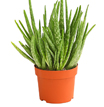

Design & constructed by Alowis.
50 B.C. Celsius, a Greek physician introduced Aloe into western medicine. Sap as laxative.
41-68 A.D. Aloe vera plant described in the book "Greek Herbal" of Dioscorides.
Sap as healing agent. Additionally, induces sleep, cleanses stomach, treatment for boils, ulcerated genitals, stops hair loss, heals tonsil, diseases of mouth and eyes.
200 A.D. Galen, Antyllus, Aretaces, and many other Southern European physicians used Aloe as medicine.
For different clinical purposes.
700-800 A.D. For the first time Chinese used Aloe vera.
For the of treatment of sinus, fever and Convulsions in children by Aloe.
1300-1500 A.D.
Aloe (dried sap) was introduced to English medicine.
For the treatment of external wounds and diseases and as purgative.
1700-1900 A.D.
Carl Von Linne, 1720, described the plant as Aloe Vera.
In 1820 Aloe vera was officially listed in United States pharmacopoeia. Aloin, The sap prepared as a purified product for commercial use. As purgative and skin protectant. For the treatment for radiation injuries, ulcers, burns, dermatitis and other skin injuries and diseases.
1950 A.D. A Russian scientist discovered the utility of Aloe vera juice for various diseases.
For the treatment of parasitic diseases and several lung disorders.
1975 A.D. Robert discovered that the plant has other multiple applications in animals.
For ringworm, skin allergies, abscess, hot spots, lacerations, inflamed cyst.
1979 A.D Suzuki et al., (1979) isolated two lectins from leaves of Aloe arborescence Miller.
Hemagglutinating and mitogenic activity.
1985A.D. Bland discovered Aloe vera juice as a clinical drink.
Helps digestive processes, controls infections andhas no toxic effects. Doctors of Department of Medicine, King Saud University, audi Arabia, stated that the dried sap of the Aloe plant is used in the Arabian peninsula for its ability to lower the blood glucose in diabetic patients. Paper concludes that Aloes contain a hypoglycemic agent which lowers the blood glucose.
1987 A.D. Burn described that the disease shingle (Herpes Zoster) is caused by the same virus that also causes chicken pox and common herpes.
Aloe vera as remedy for shingles.
1991 A.D. Davis et al., reported in two different publications about inhibitory and stimulatory systems from Aloe vera.
The Aloe extract acts as modulator-system towards wounds, inflammation and is valuable for managing lower extremity conditions.
1994 A.D Davis et al., described mannose 6-phosphate from Aloe gel.
It improves wound healing and inhibits inflammation.
1997 A.D A glycoprotein was isolated from Aloe Barbadensis Miller.
The glycoprotein promoted cell growth and proliferation of human normal dermal cells and baby hamster kidney cells.
2000 A.D. Pecere and co-workers reported Aloe emodin.
Emodin (hydroxyanthraquinones) from Aloe vera leaves has antineuroectodermal tumor activity both in vitro and vivo.
2001 A.D A glycoprotein, G1G1M1DI2, was isolated from Aloe vera.
Wound-healing via cell proliferation and migration.
2002 A.D Choi et al. isolated beta- sitosterol from Aloe Vera.
Send us a message, we will call back later